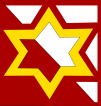
No records exist in Utrecht of Jewish presence before 1435. Money lending was possibly done (no proof is available) by Lombards (from Italy). A local residence which in medieval times was called the Lombards House still exists1. Also the religious prohibition of taking interest was – according to Bogaers – not carried out in practice in medieval Utrecht.
Yet, an indirect and not local connection exists between this trade and Utrecht. In the Utrecht Archive are contracts (1332-1349), originally owned by a Jewish banker in the Zutphen region, which finally ended up in the DOM archive. The contracts are in Latin, the banker made notes on the back in Hebrew, probably the oldest known Hebrew writing from the northern Netherlands.
Remarks

From the fact that Utrecht has been explicitly mentioned in German “Memor books” as a locus of massacre in the period of Black Death, Jac. Zwarts deducted that a Jewish community must have existed in Utrecht already before 1349. These Memor-books were also cited recently by Levie Bernfeld & Wallet.

Salfeld (1898) surveyed various memorial records “Memor books”. In his chapter V “Die Marterstätten zur Zeit des schwarzen Todes” he mentions under heading 41 (Münster (Stift)) a.o. the locations, Utrecht, Broech, Keppel, and under heading 45 (Köln) a.o. the locations Neumagen (=Nijmegen?!), Berg, Arnheim, Zutphen, Zwolle, Deventer… All these places are additions to earlier lists in memorial books (not mentioned before), taken from Memorial Books from Deutz (1531-1784), Bergheim (1677) and Rheinbach (~1650), i.e. from sources transmitted until and recorded well after the events. These records had a religious form i.e. to pray for the souls of the persecuted and murdered persons, but also kept the memories vivid. Salfeld mentions in his introduction, that an earlier review by Jellinek is “äusserst incorrect”, but that he succeeded with the additions to compose a “möglichst richtigen” text. Ultimately there is no way to check the historic reliability of the data. So even if murdering took place in the Utrecht region during the period of the Black Death, to my opinion the evidence for Jewish presence in Utrecht prior to 1435 is still too thin.
It is interesting to note furthermore that the Utrecht ‘Sticht’ and the Münster Stift are considered in the Salfeld listing as the same.
References
Jac. Zwarts – De Utrechtse Jeuderij, een jodenstraat in de Middeleeuwen – Bijdragen en Mededeelingen van het Genootschap van Joodse Wetenschap – 1925 p.61 (http://www.genootschapjoodsewetenschap.nl/downloads/BM_02_1925_040_079.pdf)
S.Salfeld – Das Martyrologium des Nürnberger Memorbuches – Berlin 1898
Tirtsah Levie Bernfeld & Bart Wallet – Canon van 700 jaar joods Nederland – Joods Maatschappelijk Werk & Joods Educatief Centrum ‘Crescas’ – Amsterdam 2015.
Obligations of various persons in the Salland region to Godschalk van Recklinchusen (and others) and a deed in which Zueder, Lord of Voerst, takes Gosscalc, the Jew of Rekelinchusen as his servant (50 charters, entry 216, nr 4234-1 to 50) in the Utrecht Archives (Het Utrechts Archief).
Llewellyn C.J.J. Bogaers – Aards, betrokken en zelfbewust : de verwevenheid van cultuur en religie in katholiek Utrecht, 1300-1600 – Utrecht 2008.
1 http://rijksmonumenten.nl/monument/450341/lombardenhuis/utrecht/ and http://nl.wikipedia.org/wiki/Lombardenhuis
